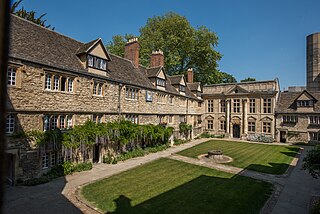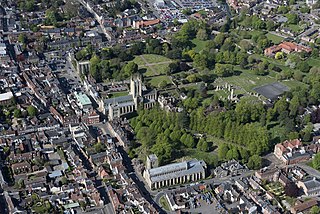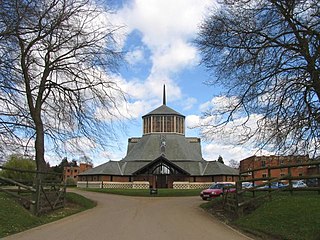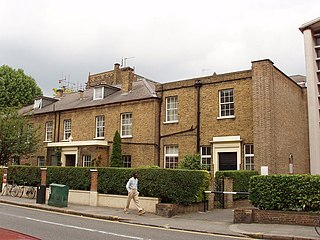
St Edmund Hall is a constituent college of the University of Oxford. The college claims to be "the oldest surviving academic society to house and educate undergraduates in any university" and was the last surviving medieval academic hall at the university.

Bury St Edmunds, commonly referred to locally as Bury, is a cathedral as well as market town and civil parish in the West Suffolk district, in the county of Suffolk, England. The town is best known for Bury St Edmunds Abbey and St Edmundsbury Cathedral. Bury is the seat of the Diocese of St Edmundsbury and Ipswich of the Church of England, with the episcopal see at St Edmundsbury Cathedral. In 2011, it had a population of 45,000. The town, originally called Beodericsworth, was built on a grid pattern by Abbot Baldwin around 1080. It is known for brewing and malting and for a British Sugar processing factory, where Silver Spoon sugar is produced. The town is the cultural and retail centre for West Suffolk and tourism is a major part of the economy.

Ashton-in-Makerfield is a market town in the Metropolitan Borough of Wigan, Greater Manchester, England, 4 miles (6.4 km) south of Wigan. As of the 2021 census, there was a population of 26,380.

Stonyhurst College or Stonyhurst is a co-educational Catholic private school, adhering to the Jesuit tradition, on the Stonyhurst Estate, Lancashire, England. It occupies a Grade I listed building. The school has been fully co-educational since 1999.

Stonyhurst is a 1,000-acre (4 km2) rural estate owned by the Society of Jesus near Clitheroe in Lancashire, England. It is centred on Stonyhurst College, occupying the great house, its preparatory school Stonyhurst Saint Mary's Hall and the parish church, St Peter's.
Bishop William Weathers was a Roman Catholic bishop of the Catholic Church in England and Wales as well the titular Bishop of Amycla. His parents were originally Protestants from Wales. He, his mother and siblings were converted to Roman Catholicism after his father's death. He was educated at the Franciscan school at Baddesley (1823–28), and at Old Hall, where he remained for forty years, and held in turn every office. Before his ordination (1838) he was already a master (1835). He was prefect of discipline 1840–43, vice-president and procurator 1843–51, prefect of studies for some years, and president 1851–68.

St Edmund's College is a coeducational private day and boarding school in the British public school tradition, set in 440 acres (1.8 km2) in Ware, Hertfordshire. Founded in 1568 as a seminary, then a boys' school, it is the oldest continuously operating and oldest post-Reformation Catholic school in the country. Today it caters for boys and girls aged 3 to 18.
The English College was a Catholic seminary in Douai, France, associated with the University of Douai. It was established in 1568, and was suppressed in 1793. It is known for a Bible translation referred to as the Douay–Rheims Bible. Of over 300 British priests who studied at the English College, about one-third were executed after returning home.

The Athenaeum of Ohio – Mount St. Mary's Seminary of the West, originally St. Francis Xavier Seminary, is a Catholic seminary in Cincinnati, Ohio. It is the third-oldest Catholic seminary in the United States and was established by Edward Fenwick, the first Bishop of Cincinnati, in 1829 along with The Athenaeum, which opened in 1831 in downtown Cincinnati.

Douai Abbey is a Benedictine Abbey at Upper Woolhampton, near Thatcham, in the English county of Berkshire, situated within the Roman Catholic Diocese of Portsmouth. Monks from the monastery of St. Edmund's, in Douai, France, came to Woolhampton in 1903 when the community left France as a result of anti-clerical legislation. The abbey church is listed Grade II* on the National Heritage List for England.

Francis Alphonsus Bourne (1861–1935) was an English prelate of the Catholic Church. He served as the fourth Archbishop of Westminster from 1903 until his death, and was elevated to the cardinalate in 1911.

Cockfield is a village and civil parish located approximately 3+1⁄2 miles (5.6 km) from Lavenham in Suffolk, England. The village consists of a central point and several outlying hamlets: Buttons Green, Colchester Green, Cross Green, Great Green, Oldhall Green, Smithwood Green and Windsor Green. Surrounded mostly by fields used for farming, and with few roads, its population was 839 in 2001, increasing to 868 at the 2011 Census.

John Norman Davidson Kelly was a British theologian and academic at the University of Oxford and Principal of St Edmund Hall, Oxford, between 1951 and 1979, during which the hall transformed into an independent constituent college of the university and later a co-educational establishment.
Leonard Hodgson was an Anglican priest, philosopher, theologian, historian of the early Church and Regius Professor of Divinity at the University of Oxford from 1944 to 1958.

Stonyhurst St Mary's Hall is the preparatory school to Stonyhurst College. It is an independent co-educational Catholic school, for ages 3–13, founded by the Society of Jesus (Jesuits). It is primarily a day school but has some boarders. As the lineal descendant of Hodder Place the school lays claim to be the oldest preparatory school in the country.

Standon is a village and civil parish in Hertfordshire, England. The parish includes the adjoining village of Puckeridge and Old Hall Green. The Grade I listed parish church of St Mary has Anglo-Saxon origins with much Victorian restoration of 1864-65 by H. and G. Godwin. The chancel contains the ornate tombs of the Tudor courtier Sir Ralph Sadler and his son Thomas Sadleir. The house Standon Lordship was built by Ralph Sadler on his estate at Standon, which he acquired in 1544; Standon remained in the possession of the Sadler family until 1660.
The principal is the chief executive and the chief academic officer of a university or college in certain parts of the Commonwealth.
This article details a number of defunct schools that were once located in the Metropolitan Borough of Dudley. For details of currently operating schools in the area, please see: List of schools in Dudley.

Allen Hall Seminary, often abbreviated to Allen Hall, is the Roman Catholic seminary and theological college of the Province of Westminster at 28 Beaufort Street in Chelsea, London, in the London Borough of Kensington and Chelsea. It is situated on the site of the house that was once occupied by St Thomas More. Though nothing of the house remains, parts of the 16th-century garden wall exist today.












